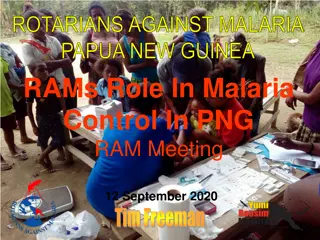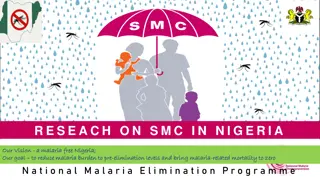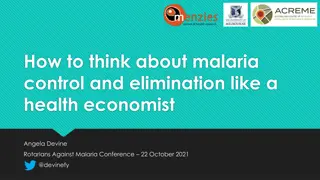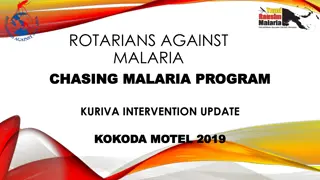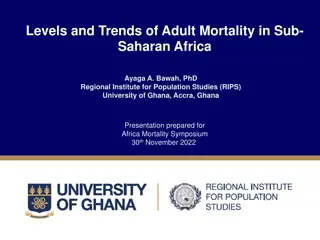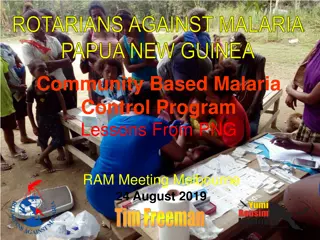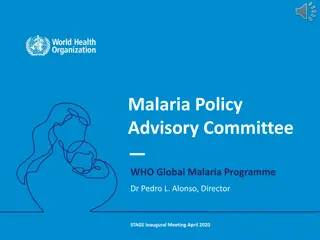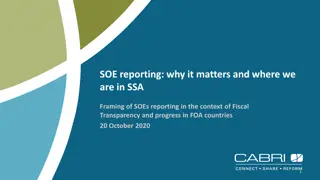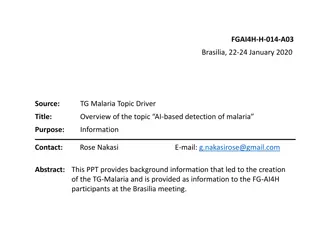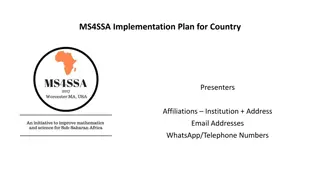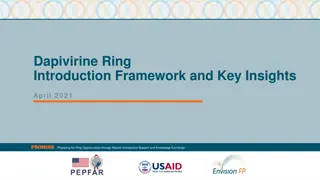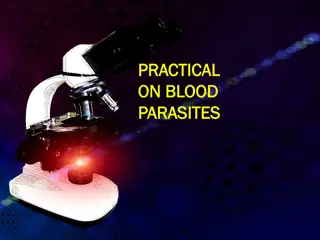The Impact of Malaria Eradication Programs in Sub-Saharan Africa
Malaria, an infectious disease transmitted by mosquitoes, poses a significant threat in Sub-Saharan Africa where over half a billion people are affected annually. Despite various efforts including global eradication programs, the focus on prevention rather than treatment is deemed crucial to minimize the disease's impact in the region. The failure of past programs, highlighted by the WHO's Global Malaria Eradication Program in the 1950s, underlines the necessity of effective prevention strategies for long-term success in combating malaria.
Download Presentation

Please find below an Image/Link to download the presentation.
The content on the website is provided AS IS for your information and personal use only. It may not be sold, licensed, or shared on other websites without obtaining consent from the author. Download presentation by click this link. If you encounter any issues during the download, it is possible that the publisher has removed the file from their server.
E N D
Presentation Transcript
An Argumentative Essay CREATED BY JACQUELINE WEAVER NORTHERN VIRGINIA COMMUNITY COLLEGE WOODBRIDGE CAMPUS
Credits: Sarikas, Christine. 3 Strong Argumentative Essay Examples, Analyzed. 3 Strong Argumentative Essay Examples, Analyzed, https://blog.prepscholar.com/argumentative-essay-examples.
Malaria is an infectious disease caused by parasites that are transmitted to people through female Anopheles mosquitoes. Each year, over half a billion people will become infected with malaria, with roughly 80% of them living in Sub-Saharan Africa. Nearly half a million people die of malaria every year, most of them young children under the age of five. Unlike many other infectious diseases, the death toll for malaria is rising. While there have been many programs designed to improve access to malaria treatment, the best way to reduce the impact of malaria in Sub-Saharan Africa is to focus on reducing the number of people who contract the disease in the first place, rather than waiting to treat the disease after the person is already infected.
https://www.yourgenome.org/video/malaria-an- introduction
First, there is prevention by global eradication programs. Even though there are multiple drugs available to treat malaria, and many of them work well and save lives, malaria eradication programs that focused too much on drugs and chemicals, and not enough on prevention haven t seen long-term success in Sub-Saharan Africa. A major program to combat malaria was WHO s Global Malaria Eradication Programme. Started in 1955, it had a goal of eliminating malaria in Africa within the next ten years. Based upon previously successful programs in Brazil and the United States, the program focused mainly on vector control. This included widely distributing chloroquine and spraying large amounts of DDT. More than one billion dollars was spent trying to abolish malaria. However, the program suffered from many problems and in 1969, WHO was forced to admit that the program had not succeeded in eradicating malaria. The number of people in Sub-Saharan Africa who contracted malaria as well as the number of malaria deaths had actually increased over 10% during the time the program was active.
Additionally, the widespread use of chloroquine has created drug resistant parasites which are now plaguing Sub-Saharan Africa. Because chloroquine was used widely but inconsistently, mosquitoes developed resistance, and chloroquine is now nearly completely ineffective in Sub-Saharan Africa, with over 95% of mosquitoes resistant to it. As a result, newer, more expensive drugs need to be used to prevent and treat malaria, which further drives up the cost of malaria treatment for a region that can ill afford it.
One of the cheapest and most effective ways of preventing malaria is to implement insecticide-treated bed nets (ITNs). These nets provide a protective barrier around the person or people using them. While untreated bed nets are still helpful, those treated with insecticides are much more useful because they stop mosquitoes from biting people through the nets, and they help reduce mosquito populations in a community, thus helping people who don t even own bed nets. Bed nets are also very effective because most mosquito bites occur while the person is sleeping, so bed nets would be able to drastically reduce the number of transmissions during the night. In fact, transmission of malaria can be reduced by as much as 90% in areas where the use of ITNs is widespread. Because money is so scarce in Sub-Saharan Africa, the low cost is a great benefit and a major reason why the program is so successful. Bed nets cost roughly 2 USD to make, last several years, and can protect two adults. Studies have shown that, for every 100-1000 more nets are being used, one less child dies of malaria. With an estimated 300 million people in Africa not being protected by mosquito nets, there s the potential to save three million lives by spending just a few dollars per person.
Some people believe that the only cause of malaria is poverty. While this disease is connected to areas of the world that have poverty, this is only part of the problem. Yes, most African countries don't have the resources to send all their people to doctors and get shots, nor can they afford to clear wetlands or other malaria prone areas. However, mosquitoes unfortunately love the tropical climate and wet conditions that many countries with malaria have. If we reduce the number of people who contract malaria first with prevention, then it would reduce poverty levels in Africa significantly, thus improving other aspects of society like education levels and the economy.
In conclusion, malaria should be prevented instead of only treated in order to eliminate it and help people to survive and economies to grow. Drugs and pesticides have proven to be minimally effective, but low-cost nets and removal of wetlands or moving people from areas where mosquitoes like to live can afford the best prevention. One day malaria will be a problem of the past for our globe. Millions of children will be saved.













